Experimental Investigation of Lithium-Ion Batteries Thermal Runaway Propagation Consequences under Different Triggering Modes
Abstract
1. Introduction
2. Construction of TR Trigger Experimental Platform
2.1. TR Reaction Chamber
2.2. LIB Material and Installation
2.3. Experimental Setup
3. Calculation and Analysis of LIB TR Propagation
4. Temperature Analyses of TR Triggered by Overheating Two Adjacent Cells
4.1. Trigger TR Simultaneously via Overheating Two Adjacent Cells at the Top Corner
4.2. Trigger TR Simultaneously via Overheating Two Adjacent Cells on the Side
4.3. Trigger TR Simultaneously via Overheating Two Adjacent Cells in the Center
5. Temperature Analyses of TR Triggered by Overheating the Whole Module
6. Comparing the Consequences of Overheating Two Adjacent Cells and Overheating the Whole LIB Module
6.1. Propagation Speed
6.2. Maximum Temperature
6.3. Mass Loss
6.4. Change of Voltage
7. Conclusions
Author Contributions
Funding
Data Availability Statement
Acknowledgments
Conflicts of Interest
References
- Saeva, R.; Sdott, R.G.; Tao, P.C.; Stefansson, H. Potential use of geothermal energy sources for the production of lithium-ion batteries. Renew. Energy 2014, 61, 17–22. [Google Scholar]
- Yang, J.; Xu, H.Y.; Yang, Z.G. An active control excitation method of three-stage brushless synchronous starter generator in electric starting mode for MEA. IEEE Access 2021, 9, 109763–109774. [Google Scholar]
- Gong, X.; Xiong, R.; Mi, C.C. Study of the characteristics of battery packs in electric vehicles with parallel-connected lithium-ion battery cells. IEEE Trans. Ind. Appl. 2015, 2, 1872–1879. [Google Scholar] [CrossRef]
- Yang, J.; Bao, X.W.; Yang, Z.G. Load Identification for the more electric aircraft distribution system based on intelligent algorithm. Aerospace 2022, 9, 350. [Google Scholar] [CrossRef]
- Cao, W. Overview of electric motor technologies used for more electric aircraft (MEA). IEEE Trans. Ind. Electron. 2012, 59, 3523–3531. [Google Scholar]
- Roboam, X.; Sareni, B.; Andrade, A. More electricity in the air: Toward optimized electrical networks embedded in more-electrical aircraft. IEEE Ind. Electron. Mag. 2012, 6, 6–17. [Google Scholar] [CrossRef]
- Cardone, M.; Gargiulo, B.; Fornaro, E. Modelling and experimental validation of a hybrid electric propulsion system for light aircraft and unmanned aerial vehicles. Energies 2021, 14, 3969. [Google Scholar] [CrossRef]
- Yang, F.T.; Fan, Z.W.; Xiang, S.; Liu, Y.; Zhao, W. Technical innovation and practice of electric aircraft in China. Acta Aeronaut. Astronaut. Sin. 2021, 42, 624619. [Google Scholar]
- Alexander, R.; Meyer, D.; Wang, J. A comparison of electric vehicle power systems to predict architectures, voltage levels, power requirements, and load characteristics of the future all-electric aircraft. In Proceedings of the 2018 IEEE Transportation Electrification Conference and Expo (ITEC), Long Beach, CA, USA, 13–15 June 2018. [Google Scholar]
- Lipu, M.H.; Hannan, M.A.; Hussain, A.; Hoque, M.M.; Ker, P.J.; Saad, M.H.M.; Ayob, A. A review of state of health and remaining useful life estimation methods for lithium-ion battery in electric vehicles: Challenges and recommendations. J. Clean. Prod. 2018, 205, 115–133. [Google Scholar] [CrossRef]
- Tariq, M.; Maswood, A.I.; Gajanayake, C.J.; Gupta, A.K. Aircraft batteries: Current trend towards more electric aircraft. IET Electro Syst Transp. 2017, 7, 93–103. [Google Scholar] [CrossRef]
- Gandoman, F.H.; Jaguemont, J.; Goutam, S.; Gopalakrishnan, R.; Firouz, Y.; Kalogiannis, T.; Omar, N.; Van Mierlo, J. Concept of reliability and safety assessment of lithium-ion batteries in electric vehicles: Basics, progress, and challenges. Appl. Energy 2019, 251, 113343. [Google Scholar] [CrossRef]
- Chombo, P.V.; Laoonual, Y. A review of safety strategies of a Li-ion battery. J. Power Sources 2020, 478, 228649. [Google Scholar] [CrossRef]
- Williard, N.; He, W.; Hendricks, C.; Pecht, M. Lessons learned from the 787 Dreamliner issue on lithium-ion battery reliability. Energies 2013, 6, 4682–4695. [Google Scholar] [CrossRef]
- Anon. Aircraft Incident Report: Auxiliary Power Unit Battery Fire, Japan Airlines Boeing 87-8, Ja829j; National Transportation Safety Board: Washington, DC, USA, 2014.
- Werfelman, L. Testing the limits: The NTSB calls for new tests to prove lithium-ion battery installations in aircraft can mitigate hazards tied to thermal runaway. Aerosaf. World 2014, 9, 41–43. [Google Scholar]
- Feng, X.; Ouyang, M.; Liu, X.; Lu, L.; Xia, Y.; He, X. Thermal runaway mechanism of lithium-ion battery for electric vehicles: A review. Energy Storage Mater. 2017, 10, 246–267. [Google Scholar] [CrossRef]
- Zhang, L.; Zhao, P.; Xu, M.; Wang, X. Computational identification of the safety regime of Li-ion battery thermal runaway. Appl. Energy 2019, 261, 114440. [Google Scholar] [CrossRef]
- Xu, B.; Lee, J.; Kwon, D.; Kong, L.; Pecht, M. Mitigation strategies for Li-ion battery thermal runaway: A review. Renew. Sustain. Energy Rev. 2021, 150, 111437. [Google Scholar] [CrossRef]
- FAA TSO-C179b; Rechargeable Lithium Batteries and Battery Systems. 2018. Available online: https://drs.faa.gov/browse/TSO/doctypeDetails?modalOpened=true (accessed on 25 May 2024).
- SAE. J2464; Electric and Hybrid Electric Vehicle Rechargeable Energy Storage System (RESS) Safety and Abuse Testing. 2009. Available online: https://www.sae.org/standards/content/j2464_200911/ (accessed on 25 May 2024).
- RTCA DO-311A; Minimum Operational Performance Standards for Rechargeable Lithium Batteries and Battery Systems. 2017. Available online: https://standards.globalspec.com/std/10270501/rtca-do-311 (accessed on 25 May 2024).
- RTCA DO-347; Certification Test Guidance for Small and Medium Sized Rechargeable Lithium Batteries and Battery Systems. 2013. Available online: https://standards.globalspec.com/std/1661419/rtca-do-347 (accessed on 25 May 2024).
- EASA Special Condition Doc. No: SC-VTOL-01, Vertical Take-Off and Landing (VTOL) Aircraft. 2019. Available online: https://www.easa.europa.eu/sites/default/files/dfu/SC-VTOL-01.pdf (accessed on 25 May 2024).
- Ping, P.; Kong, D.; Zhang, J.; Wen, R.; Wen, J. Characterization of behavior and hazards of fire and deflagration for high-energy Li-ion cells by over-heating. J. Power Sources 2018, 398, 55–66. [Google Scholar] [CrossRef]
- Ping, P.; Wang, Q.; Huang, P.; Li, K.; Sun, J.; Kong, D.; Chen, C. Study of the fire behavior of high-energy lithium-ion batteries with full-scale burning test. J. Power Sources 2015, 285, 80–89. [Google Scholar] [CrossRef]
- Jia, Z.; Huang, Z.; Zhai, H.; Qin, P.; Zhang, Y.; Li, Y.; Wang, Q. Experimental investigation on thermal runaway propagation of 18650 lithium-ion battery modules with two cathode materials at low pressure. Energy 2022, 251, 123925. [Google Scholar] [CrossRef]
- Chen, X.; Zhang, X.; Wang, H.; Jia, J.; Xie, S.; Zhi, M.; Fu, J.; Sun, Q. Influence of ambient pressure and heating power on the thermal runaway features of lithium-ion battery. J. Electrochem. Energy Convers. Storage 2020, 18, 021014. [Google Scholar] [CrossRef]
- Xie, S.; Ren, L.; Yang, X.; Wang, H.; Sun, Q.; Chen, X.; He, Y. Influence of cycling aging and ambient pressure on the thermal safety features of lithium-ion battery. J. Power Sources 2020, 448, 227425.1–227425.8. [Google Scholar] [CrossRef]
- Zhai, H.; Li, H.; Ping, P.; Huang, Z.; Wang, Q. An experimental-based Domino prediction model of thermal runaway propagation in 18,650 lithium-ion battery modules. Int. J. Heat Mass Transf. 2021, 181, 122024. [Google Scholar] [CrossRef]
- Feng, X.; He, X.; Ouyang, M.; Wang, L.; Lu, L.; Ren, D.; Santhanagopalan, S. A coupled electrochemical-thermal failure model for predicting the thermal runaway behavior of lithium-ion batteries. J. Electrochem. Soc. 2018, 165, A3748. [Google Scholar] [CrossRef]
- Wang, H.B.; Li, Y.; Wang, Q.Z.; Du, Z.M.; Feng, X.N. Experimental study on the thermal runaway and its propagation of a lithium-ion traction battery with NCM cathode under thermal abuse. Chin. J. Eng. 2021, 43, 663–675. [Google Scholar]
- Qi, C.; Kuang, N.N.; Zhang, Y.J. Simulation study on the thermal propagation behavior of high energy density lithium-ion battery module. High Volt. Eng. 2021, 47, 2633–2643. [Google Scholar]
- Zhang, M.; Feng, X.; Ouyang, M.; Lu, L.; Wang, F.; Fan, B. Experiments and modeling of nail penetration thermal runaway in a NCM li-ion power battery. Automot. Eng. 2015, 37, 743–751. [Google Scholar]
- Feng, X. Mechanism, Modeling and Prevention and Control of Thermal Runaway of Automotive Lithium Ion Power Battery. Ph.D. Thesis, Tsinghua University, Beijing, China, 2016. [Google Scholar]
- Kin, G.H.; Pesaran, A.; Spotnitz, R. A three-dimensional thermal abuse model for lithium-ion cells. J. Power Sources 2007, 170, 476–489. [Google Scholar]
- Hatchard, T.D.; MacNeil, D.D.; Basu, A.; Dahn, J.R. Thermal model of cylindrical and prismatic lithium-ion cells. J. Electrochem. Soc. 2001, 148, A755–A761. [Google Scholar] [CrossRef]
- Spotnitz, R.; Franklin, J. Abuse behavior of high-power, lithium-ion cells. J. Power Sources 2003, 113, 81–100. [Google Scholar] [CrossRef]
- Wang, H.Y.; Tang, A.D.; Huang, K.L. Oxygen evolution in overcharged LixNi1/3Co1/3Mn1/3O2 electrode and its thermal analysis kinetics. Chin. J. Chem. 2011, 29, 6. [Google Scholar] [CrossRef]
- Liu, Y.; Zhang, L.; Ding, Y.; Huang, X.; Huang, X. Effect of thermal impact on the onset and propagation of thermal runaway over cylindrical Li-ion batteries. Renew. Energy 2024, 222, 119910. [Google Scholar] [CrossRef]
- Yang, D.; Wang, Y.; Pan, R.; Chen, R.; Chen, Z. A neural network based state-of-health estimation of lithium-ion battery in electric vehicles. Energy Procedia 2017, 105, 2059–2064. [Google Scholar] [CrossRef]
- Yao, L.; Xu, S.; Tang, A.; Zhou, F.; Hou, J.; Xiao, Y.; Fu, Z. A Review of lithium-ion battery state of health estimation and prediction methods. World Electr. Veh. J. 2021, 12, 113. [Google Scholar] [CrossRef]
- Yang, J.; Niu, J.H.; Zhang, Q.S. In-situ explosion limit of thermal runaway gas explosion in cyclic aging lithium-ion batteries: Experimental analysis. Acta Aeronaut. Astronaut. Sin. 2023, 44, 290–299. [Google Scholar]

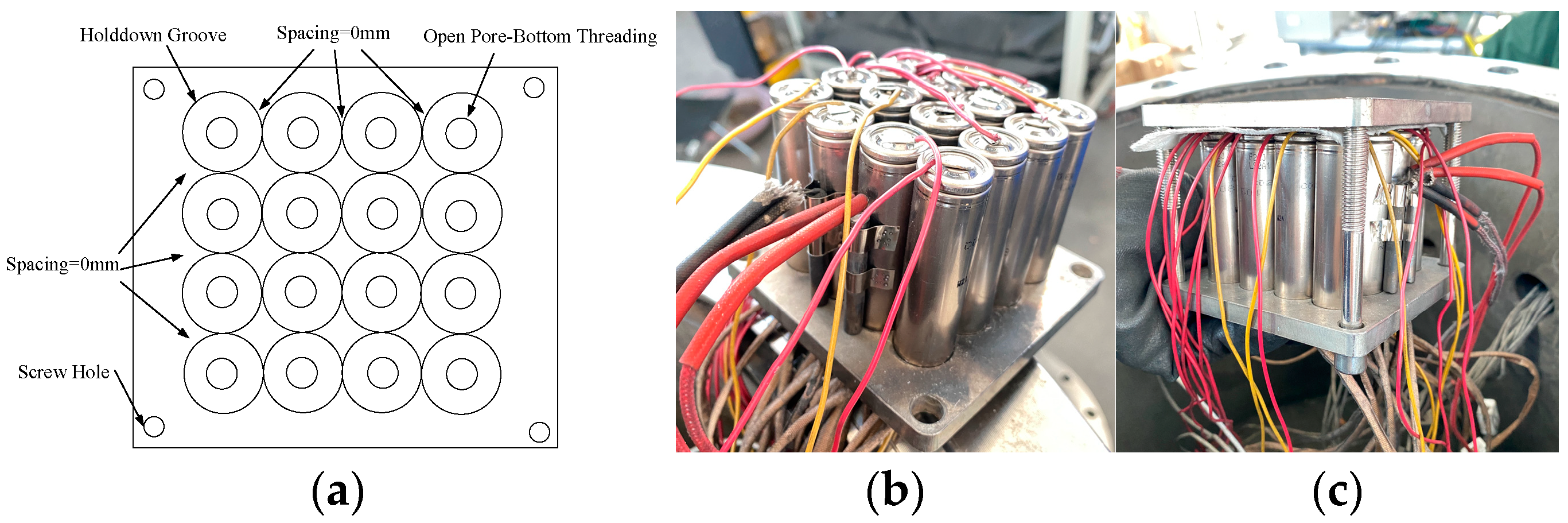
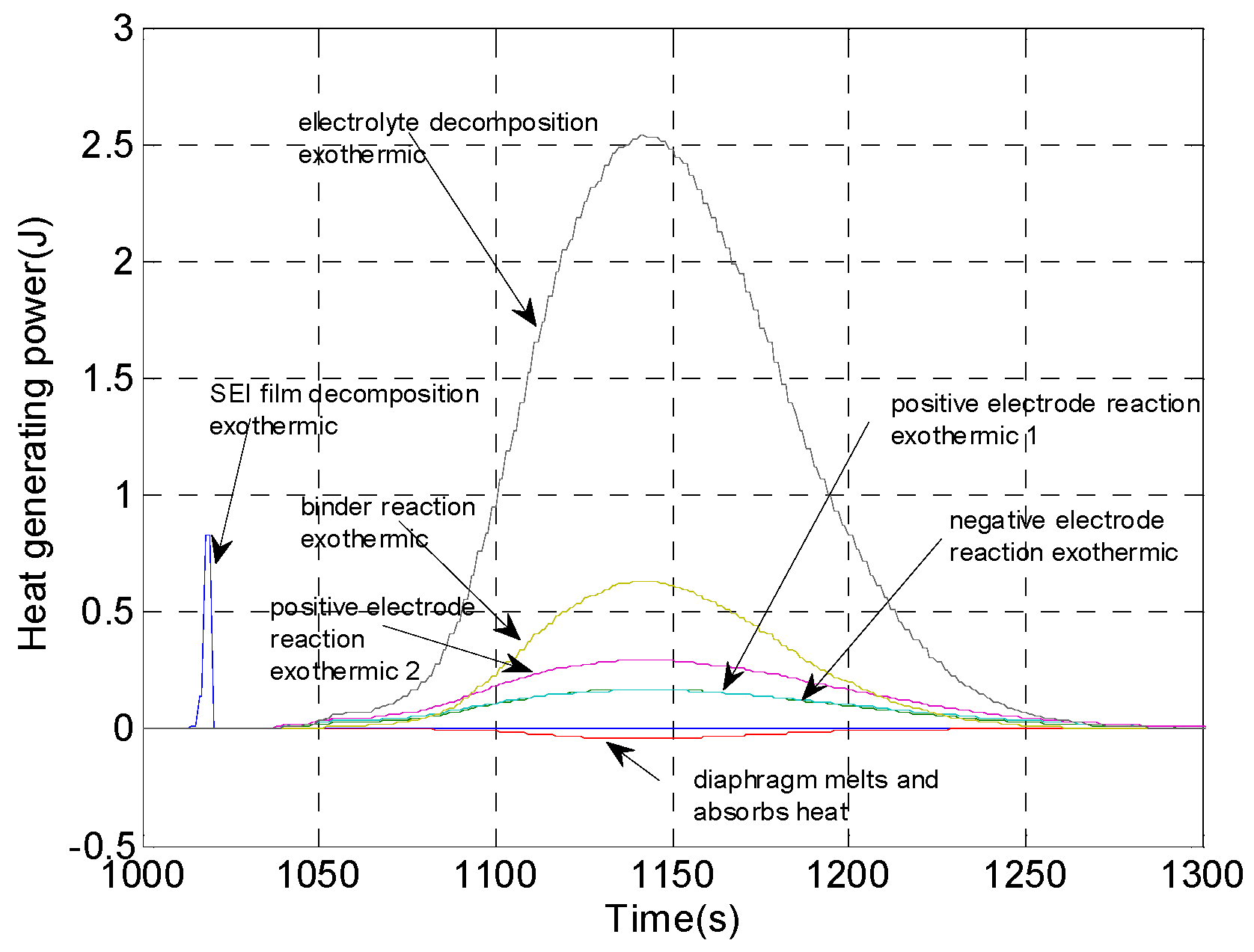

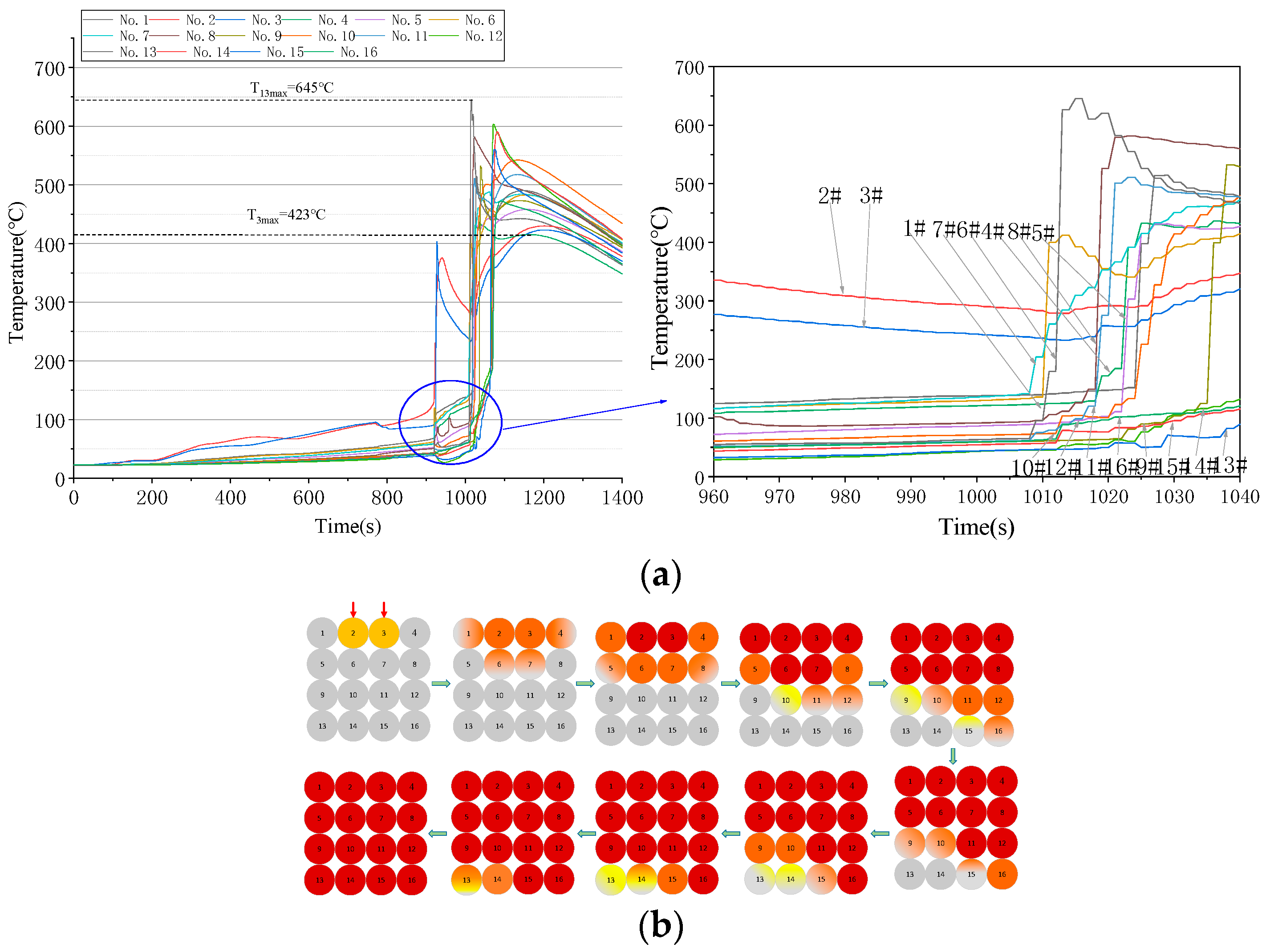
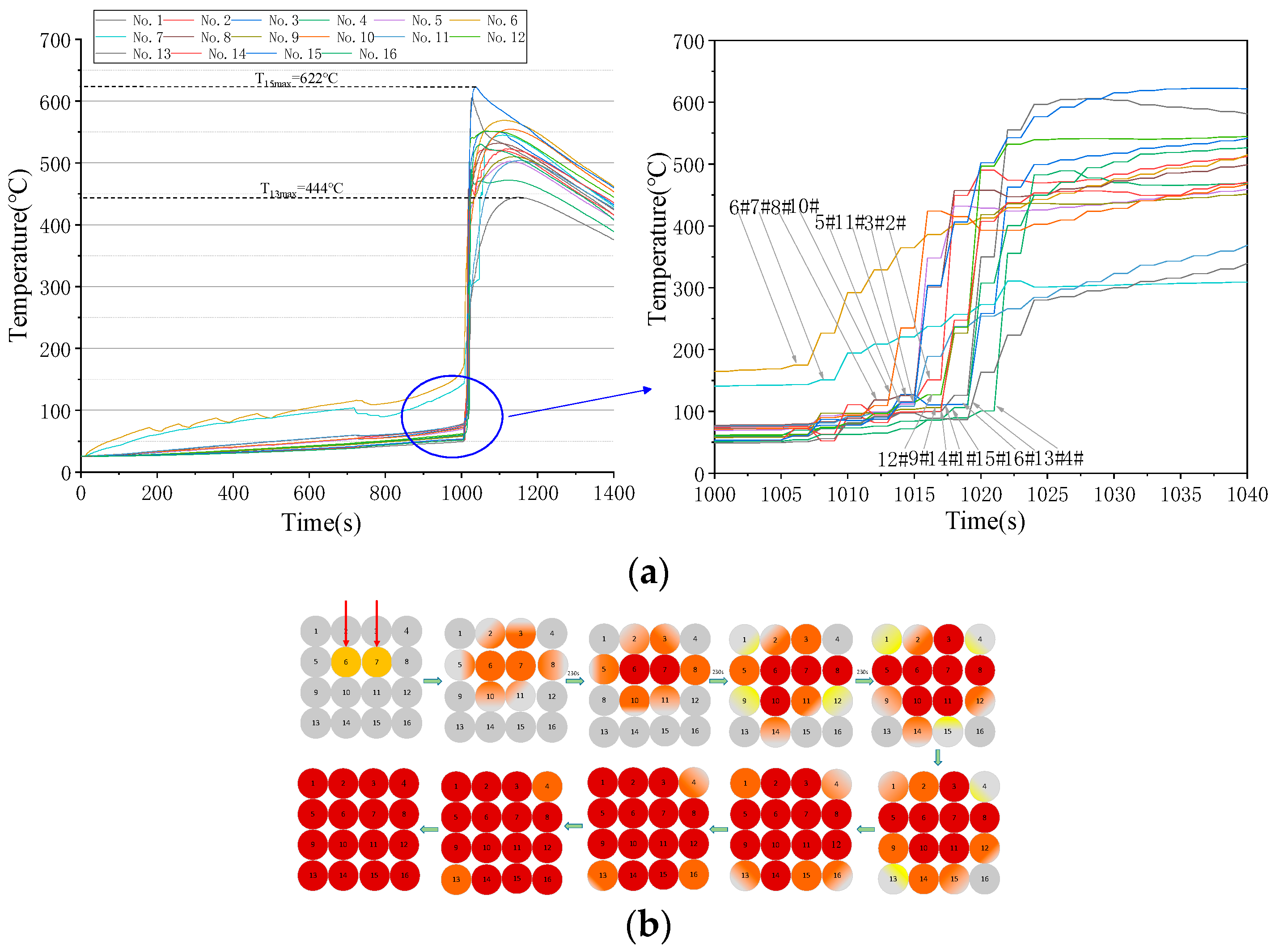
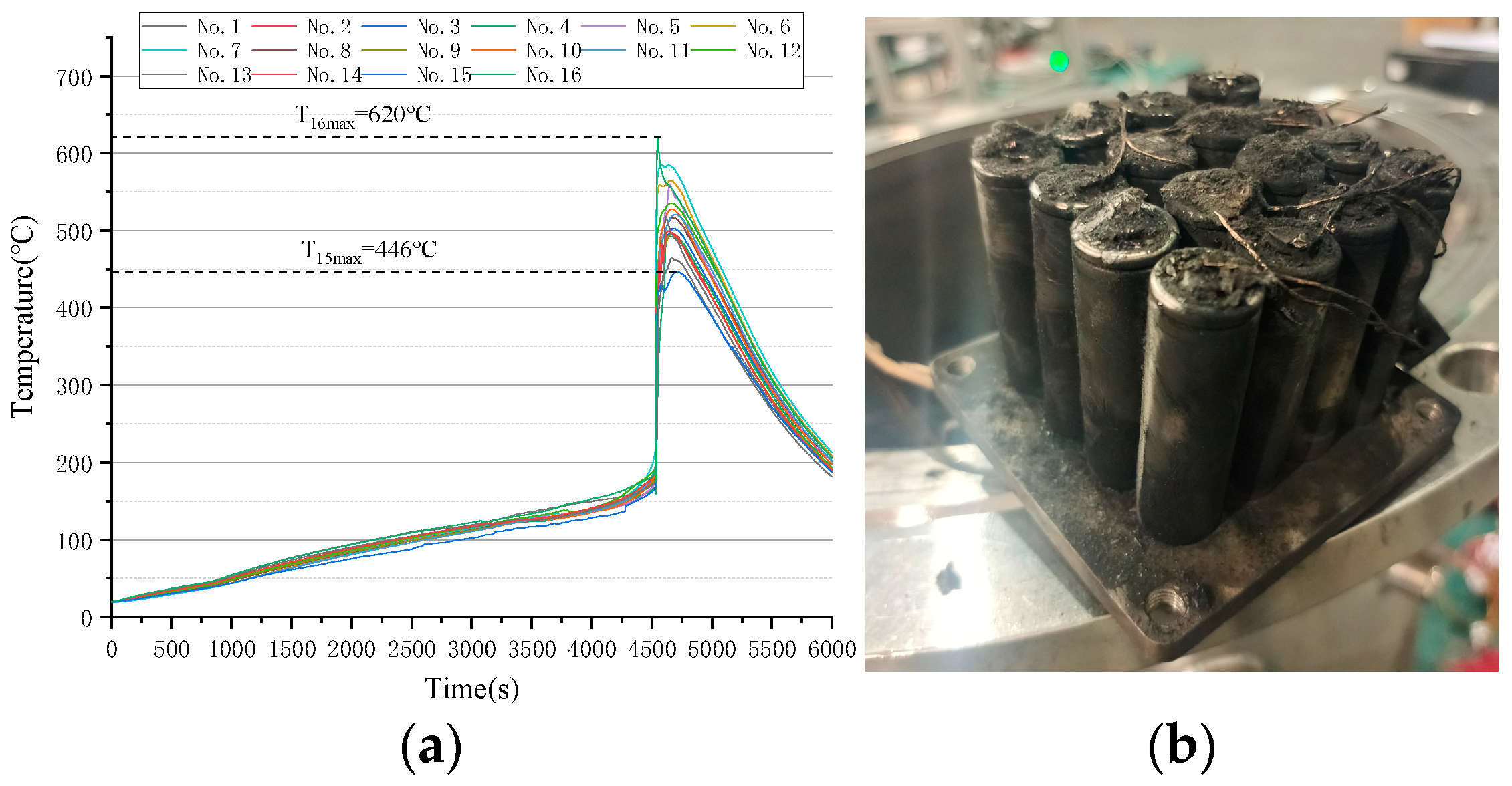
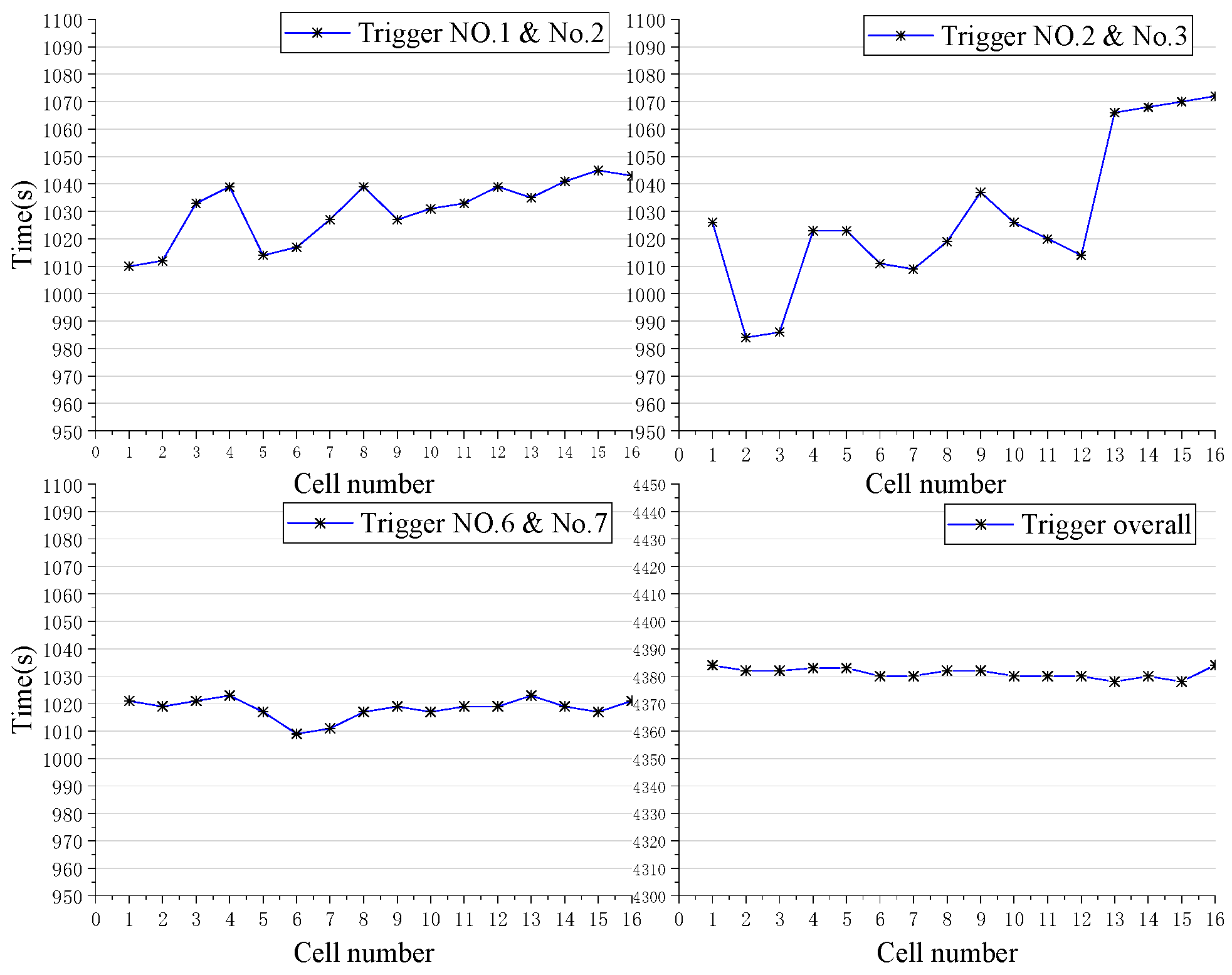


| Calculated Value | Trigger Model | |||
|---|---|---|---|---|
| 1 + 2 | 2 + 3 | 6 + 7 | Whole | |
| TR quantity | 16 | 16 | 16 | 16 |
| TR time (s) | 34 | 88 | 14 | 6 |
| TR rate (s−1) | 0.47 | 0.18 | 1.143 | 2.67 |
| Temperature (°C) | Trigger Model | |||
|---|---|---|---|---|
| 1 + 2 | 2 + 3 | 6 + 7 | Whole | |
| No. 1 | 485.24 | 514.56 | 605.91 | 464.26 |
| No. 2 | 459.15 | 430.08 | 521.24 | 495.52 |
| No. 3 | 490.04 | 423.28 | 550.71 | 502.75 |
| No. 4 | 486.0 | 436.06 | 489.00 | 493.20 |
| No. 5 | 424.08 | 458.31 | 502.69 | 559.53 |
| No. 6 | 543.88 | 482.74 | 568.61 | 564.14 |
| No. 7 | 565.7 | 488.22 | 544.66 | 585.08 |
| No. 8 | 491.67 | 581.53 | 531.61 | 516.75 |
| No. 9 | 497.84 | 532.27 | 509.99 | 495.18 |
| No. 10 | 542.82 | 542.39 | 554.30 | 527.82 |
| No. 11 | 486.7 | 517.73 | 503.65 | 520.99 |
| No. 12 | 498.04 | 560.37 | 551.35 | 535.75 |
| No. 13 | 550.74 | 645.25 | 444.16 | 518.90 |
| No. 14 | 646.82 | 603.20 | 522.55 | 598.94 |
| No. 15 | 555.05 | 590.78 | 622.54 | 446.45 |
| No. 16 | 490.31 | 472.34 | 530.23 | 620.22 |
| Trigger Mode | Calculated Value | ||
|---|---|---|---|
(°C) | Total Released Energy (J) | Mean Released Energy (J) | |
| 1 + 2 | 7094.08 | 284,827.3 | 17,801.7 |
| 2 + 3 | 8279.11 | 287,438.3 | 17,964.9 |
| 6 + 7 | 8553.2 | 298,443.0 | 18,652.7 |
| Whole | 8445.48 | 294,118.0 | 18,382.4 |
| Calculated Value | Trigger Model | |||
|---|---|---|---|---|
| 1 + 2 | 2 + 3 | 6 + 7 | Whole | |
| Total lost mass (g) | 215.53 | 220.397 | 198.261 | 231.331 |
| Total energy (J) | 71,502.0 | 71,946.2 | 71,871.9 | 82,437.8 |
Disclaimer/Publisher’s Note: The statements, opinions and data contained in all publications are solely those of the individual author(s) and contributor(s) and not of MDPI and/or the editor(s). MDPI and/or the editor(s) disclaim responsibility for any injury to people or property resulting from any ideas, methods, instructions or products referred to in the content. |
© 2024 by the authors. Licensee MDPI, Basel, Switzerland. This article is an open access article distributed under the terms and conditions of the Creative Commons Attribution (CC BY) license (https://creativecommons.org/licenses/by/4.0/).
Share and Cite
Yang, J.; Liu, W.; Zhao, H.; Zhang, Q. Experimental Investigation of Lithium-Ion Batteries Thermal Runaway Propagation Consequences under Different Triggering Modes. Aerospace 2024, 11, 438. https://doi.org/10.3390/aerospace11060438
Yang J, Liu W, Zhao H, Zhang Q. Experimental Investigation of Lithium-Ion Batteries Thermal Runaway Propagation Consequences under Different Triggering Modes. Aerospace. 2024; 11(6):438. https://doi.org/10.3390/aerospace11060438
Chicago/Turabian StyleYang, Juan, Wenhao Liu, Haoyu Zhao, and Qingsong Zhang. 2024. "Experimental Investigation of Lithium-Ion Batteries Thermal Runaway Propagation Consequences under Different Triggering Modes" Aerospace 11, no. 6: 438. https://doi.org/10.3390/aerospace11060438
APA StyleYang, J., Liu, W., Zhao, H., & Zhang, Q. (2024). Experimental Investigation of Lithium-Ion Batteries Thermal Runaway Propagation Consequences under Different Triggering Modes. Aerospace, 11(6), 438. https://doi.org/10.3390/aerospace11060438






